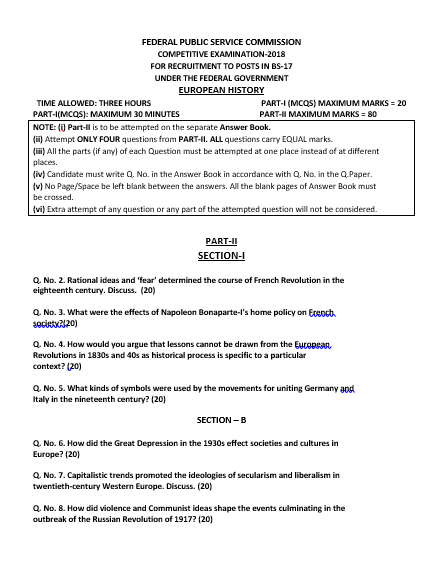Table of Contents
ToggleEuropean History 2018
SECTION-I
No. 2. Rational ideas and ‘fear’ determined the course of the French Revolution in the eighteenth century. Discuss. (20)
No. 3. What were the effects of Napoleon Bonaparte-I’s home policy on French society? (20)
No. 4. How would you argue that lessons cannot be drawn from the European Revolutions in the 1830s and 40s as a historical process is specific to a particular context? (20)
No. 5. What kinds of symbols were used by the movements for uniting Germany and Italy in the nineteenth century? (20)
SECTION – B
No. 6. How did the Great Depression in the 1930s affect societies and cultures in Europe? (20)
No. 7. Capitalistic trends promoted the ideologies of secularism and liberalism in twentieth-century Western Europe. Discuss. (20)
No. 8. How did violence and Communist ideas shape the events culminating in the outbreak of the Russian Revolution of 1917? (20)
Summaries of Questions:
No. 2: Rational ideas and ‘fear’ determined the course of the French Revolution in the eighteenth century. Discuss.
The French Revolution was influenced by both rational ideas, such as Enlightenment principles of equality, liberty, and democracy, and the fear of continued social injustice and oppression. Philosophers like Rousseau and Voltaire inspired revolutionary ideals, while the fear of famine, inequality, and the monarchy’s repressive policies fueled the drive for change. These elements combined to create a volatile situation, ultimately leading to the overthrow of the monarchy and the rise of radical movements.
No. 3: What were the effects of Napoleon Bonaparte-I’s home policy on French society?
Napoleon’s domestic policies had a profound impact on French society. He stabilized the economy through reforms like the Napoleonic Code, which standardized laws and guaranteed civil rights. He promoted education and infrastructure development while consolidating his power. However, his centralization of authority and authoritarian rule limited political freedoms, even as he implemented some revolutionary ideals. His reforms modernized French society but also reinforced his control over it.
No. 4: How would you argue that lessons cannot be drawn from the European Revolutions in the 1830s and 40s as a historical process is specific to a particular context?
The European Revolutions of the 1830s and 40s were products of specific political, social, and economic conditions unique to that time and place. While they shared common themes of discontent and demands for change, the outcomes were shaped by local circumstances such as the nature of the ruling regimes, the role of nationalism, and the influence of other European powers. Drawing universal lessons ignores the complexity of these contexts and the unique factors influencing each revolution.
No. 5: What kinds of symbols were used by the movements for uniting Germany and Italy in the nineteenth century?
The movements for unification in Germany and Italy used various symbols to rally support. In Italy, symbols like the Italian flag, the figure of Garibaldi, and the image of the Italian peninsula as a unified nation were important. In Germany, symbols included the Prussian eagle and the figure of Bismarck, who personified German unity. These symbols helped foster national identity and unite diverse groups under a common cause.
No. 6: How did the Great Depression in the 1930s affect societies and cultures in Europe?
The Great Depression caused widespread economic hardship in Europe, leading to mass unemployment, poverty, and political instability. It fueled social unrest and contributed to the rise of extremist political movements, including fascism and communism. The depression also led to changes in cultural attitudes, as many people began to question traditional values and embrace new ideologies. The crisis altered European societies by creating a sense of fear and uncertainty about the future.
No. 7: Capitalistic trends promoted the ideologies of secularism and liberalism in twentieth-century Western Europe. Discuss.
In the twentieth century, the growth of capitalism in Western Europe contributed to the spread of secularism and liberalism. Economic expansion led to increased individualism and a focus on personal freedoms, which supported secular, non-religious ideologies. At the same time, liberal political movements gained ground, advocating for democracy, civil rights, and market-driven economies. Capitalism and industrialization helped transform European societies, encouraging a shift toward secular, liberal values.
No. 8: How did violence and Communist ideas shape the events culminating in the outbreak of the Russian Revolution of 1917?
Violence and Communist ideas were central to the Russian Revolution of 1917. The violent repression of workers, peasants, and soldiers by the Tsarist regime, along with the harsh conditions of World War I, sparked widespread discontent. Communist ideologies, particularly those of Marx and Lenin, offered a revolutionary alternative to the monarchy and capitalism. The combination of popular unrest, the appeal of Communism, and violent confrontations led to the abdication of the Tsar and the rise of Bolshevik power.
